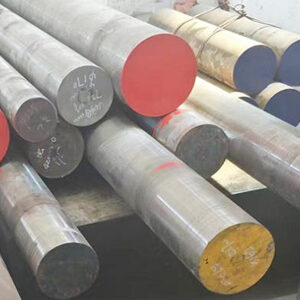When it comes to precision manufacturing, CNC machining stands out as one of the most reliable and efficient methods. Among the various raw materials used in this process, bar stock metal has become the go-to choice for many machinists and manufacturers. But why is that the case? In this article, we’ll explore five compelling facts that explain why bar stock metal continues to dominate the world of CNC machining.
Table of Contents
Introduction:

Bar stock metal refers to long, straight pieces of metal—typically steel, aluminum, brass, or stainless steel—that are used as raw material in machining processes. These bars come in various diameters and lengths, and are often fed into CNC lathes or mills to produce complex parts with high precision.
In the context of Computer Numerical Control (CNC) machining, bar stock is valued for its uniformity, ease of handling, and compatibility with automated systems. Whether you’re producing a few prototypes or thousands of parts, bar stock provides a consistent and scalable solution. Let’s dive into the key reasons why this material is so dominant in modern machining environments.
Cost-Effectiveness: Reducing Material Waste and Labor Costs
One of the primary reasons why bar stock metal is favored in CNC machining is its cost-effectiveness. Compared to other forms of raw materials like castings or forgings, bar stock minimizes material waste during the machining process, which ultimately helps reduce overall production costs. The savings can be significant, especially when considering the reduction in scrap material and labor expenses.
- Precision Machining Reduces Scrap: CNC machines are designed to remove only the necessary amount of material to shape a part, resulting in a highly precise machining process. This allows bar stock to provide tight control over material usage, reducing the likelihood of overcutting and minimizing scrap. The result is not only a more efficient use of the material but also a reduction in the need for excess raw stock, which can add up in terms of cost over time.
- Lower Tooling Costs: One of the key advantages of using bar stock over other materials is that it doesn’t require complex molds or tooling like casting or injection molding. This greatly reduces upfront costs associated with specialized tooling, which can be expensive and time-consuming to produce. With bar stock, manufacturers can focus on machining processes that are more straightforward, saving both time and money during the production stage.
- Efficient Batch Production: Bar stock is particularly advantageous for efficient batch production. Many CNC machines can automatically feed bar stock through a collet, enabling lights-out manufacturing. This means that machines can run continuously, with little to no human intervention, significantly reducing labor costs. This level of automation helps streamline the production process, especially for medium to high-volume production runs, where cost savings over time can be substantial. The ability to produce a large number of parts with minimal labor not only drives down costs but also increases production throughput.
This combination of reduced material waste, lower tooling costs, and efficient batch production makes bar stock particularly attractive for industries that require high precision and consistent output, including automotive, aerospace, and electronics manufacturing. The resulting cost-effectiveness allows manufacturers to maintain competitive pricing while delivering high-quality parts.
Material Consistency: Ensuring Quality and Reliability

In manufacturing, consistency is crucial, especially when tight tolerances and repeatable quality are required. Bar stock metal offers superior material consistency across batches, making it an essential choice for industries where uniformity is a necessity for reliable and safe products.
- Predictable Machining Behavior: One of the key advantages of bar stock is its homogeneous composition, which ensures predictable machining behavior. Unlike materials like castings, which may have variations due to cooling rates or manufacturing techniques, bar stock metal’s consistent structure ensures that cutting tools perform uniformly. This not only reduces tool wear but also extends the lifespan of machining equipment, further optimizing production costs.
- Uniform Mechanical Properties: Bar stock offers the advantage of uniform mechanical properties. Unlike some cast or forged components, which may exhibit variable properties due to factors like grain structure or cooling rates, bar stock maintains uniform strength, hardness, and ductility. This ensures that the final parts meet the expected mechanical performance standards across batches. Such consistency is especially important in industries like aerospace and medical device manufacturing, where even the smallest variation in material properties can lead to critical part failures.
- Traceability and Standards Compliance: Bar stock is often sourced from certified suppliers, meaning that it typically comes with detailed specifications and certificates of compliance. These documents provide crucial traceability, ensuring that manufacturers can verify material quality and meet industry standards such as ASTM, ASME, or ISO. For industries where regulatory compliance and safety are of paramount importance, this traceability offers a significant advantage, reducing the risk of non-compliance and ensuring that parts meet rigorous quality standards.
For industries such as aerospace, medical devices, and automotive, where part failure can have serious consequences, this consistency is not just a benefit—it’s a necessity. By using bar stock, manufacturers can confidently produce parts that will meet safety, durability, and reliability requirements, minimizing the risk of product recalls and failures.
Versatility in Applications: From Prototyping to Mass Production

Another major advantage of bar stock metal is its remarkable versatility. This flexibility makes it an excellent choice for a broad range of manufacturing applications, from prototyping to large-scale mass production.
- Prototyping: Bar stock offers significant advantages for prototyping. With its availability in standard shapes and sizes, machinists can quickly turn a design into a functional prototype without the need for custom molds or patterns. This quick turnaround time allows manufacturers to test and iterate designs faster, ultimately speeding up the overall product development process. Whether it’s for small-scale custom parts or initial design validation, bar stock provides an efficient and cost-effective solution for prototyping.
- Custom Components: Beyond prototyping, bar stock is ideal for creating custom components. Manufacturers can use bar stock to produce highly specialized parts with unique geometries that might not be feasible with other production methods. Whether it’s an intricate shape or a part with precise dimensions, bar stock allows for the flexibility to create a wide variety of custom components without the limitations imposed by casting or injection molding processes.
- High-Volume Production: Bar stock is also well-suited for high-volume production. Thanks to automated bar feeders and CNC lathes, manufacturers can produce thousands of identical parts quickly and efficiently. With minimal human intervention required, the cost per part decreases as production volumes increase, making bar stock an excellent choice for large-scale manufacturing. Whether producing threaded fasteners, shafts, valve bodies, or connectors, CNC machining with bar stock ensures both precision and consistency at scale.
From simple components to complex assemblies, bar stock metal supports a broad range of applications. This makes it an attractive and versatile material for a wide range of industries, from automotive and electronics to industrial machinery and medical device manufacturing.
Conclusion
In conclusion, bar stock metal has become the backbone of CNC machining for good reason. Its cost-effectiveness, material consistency, and versatility make it an ideal choice for both small-scale prototyping and large-scale production. As industries continue to demand higher precision, faster turnaround times, and tighter tolerances, bar stock remains a reliable and adaptable solution.
Whether you’re a seasoned machinist or a product designer exploring manufacturing options, understanding the advantages of bar stock can help you make more informed decisions. In the evolving landscape of modern manufacturing, bar stock metal isn’t just dominant—it’s indispensable.
FAQ
Q1: Why is tool steel bar stock preferred for high-precision CNC machining?
A: Tool steels (e.g., H13, D2, S7) offer superior hardness (HRC 50-62), wear resistance, and thermal stability – critical for tight-tolerance cutting. For example, Qilu’s H13 bar stock maintains dimensional accuracy even at 500°C+ temperatures, reducing tool wear by 30% compared to standard alloys.
Q2: How do I choose between P20, H13, and S7 bar stock for mold making?
A: Follow this decision matrix:
- P20: Low-cost option for plastic injection molds (<100k cycles)
- H13: Best for high-temperature die casting (zinc/aluminum)
- S7: Ideal for impact-resistant tools (punching/shearing)
Pro Tip: Qilu provides free material selection guides with fatigue resistance data.
Q3: Can bar stock metal reduce lead times for custom parts?
A: Absolutely. Pre-machined Qilu tool steel blanks (e.g., pre-ground D2 bars) cut processing steps by 40%. Our inventory includes 500+ metric sizes for 24hr shipment to EU/US factories.
Q4: What certifications ensure bar stock quality for aerospace applications?
A: Demand these 3 certifications:
- EN 10204 3.1 Material Certs (traceability)
- ISO 9001:2015 (process control)
- AMS 2750 (pyrometry compliance)
Qilu certs include full composition reports and ultrasonic testing logs.
Q5: How does China’s tool steel export duty affect B2B pricing?
A: As of 2025, China’s 13% VAT rebate on alloy steel exports makes brands like Qilu 15-20% cheaper than EU suppliers – without compromising on:
- Decarburization control (<0.1mm depth)
- Inclusion rating (ASTM E45 Class A)
Request our duty-optimized quotation templates.
✨ Let’s Stay Connected!

If you enjoyed this blog on mechanical parts processing, don’t forget to join me on social media for more insights, updates, and community discussions.
📘 Facebook – Connect with me here
Let’s keep exploring, learning, and growing together. Thanks for reading, and see you in the next post! 🚀

